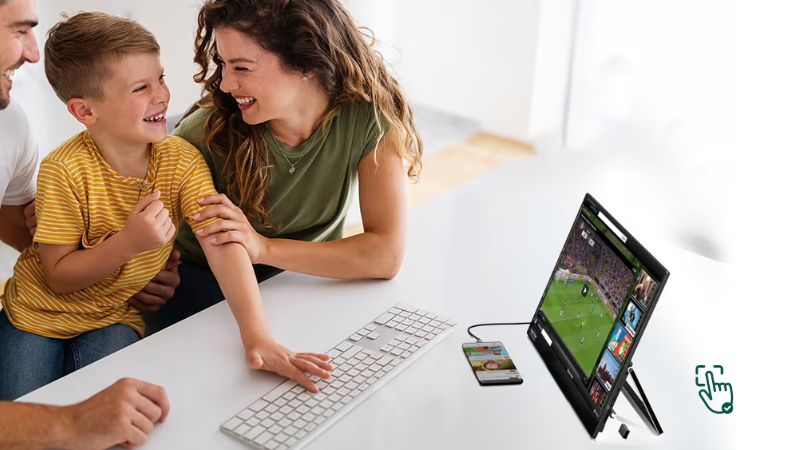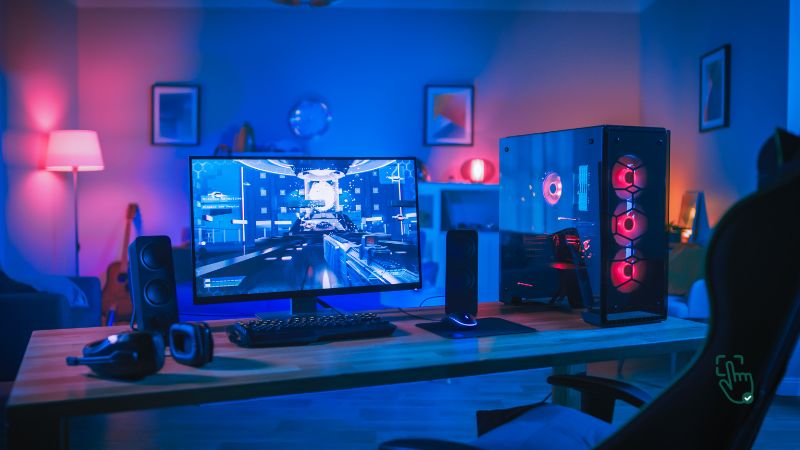
Ever find yourself juggling multiple tabs on your laptop, wishing for a second screen to magically appear? Enter the wireless monitor for laptop — a game-changer for multitaskers, gamers, and digital nomads alike. With a portable, wireless computer monitor, you can boost productivity and enjoy a clutter-free setup without dealing with a tangle of cables. But how do you choose the right one? Let’s break it down.
What is a Wireless Monitor?
A wireless monitor for laptops provides a cable-free display solution, enhancing productivity and reducing desk clutter—perfect for remote workers, creatives, and multitaskers. Most wireless monitors use Wi-Fi Direct, Miracast, or USB-C for screen transmission rather than Bluetooth, as Bluetooth lacks the bandwidth needed for high-quality video streaming.
Why Choose a Wireless Monitor for Your Laptop?
In today’s fast-paced world, mobility and convenience are everything. A wireless monitor offers seamless connectivity without the hassle of cords. Whether you’re working remotely, gaming, or creating content, these monitors make your life easier by offering:
- Portability: Lightweight and travel-friendly for on-the-go productivity.
- Wireless Convenience: No cables needed with Wi-Fi Direct or USB-C wireless display.
- Clutter-Free Workspace: A minimalist setup with no tangled wires.
- Extended Screen Real Estate: Boost efficiency with a second screen for multitasking.
Key Features to Look for in a Wireless Monitor
Not all wireless monitors for laptops are created equal. Here’s what to keep in mind when shopping:
1. Screen Size and Resolution
- Choose a size that complements your laptop, typically between 13 to 17 inches.
- Look for Full HD (1080p) or higher for crisp visuals.
2. Battery Life
- Opt for a monitor with long battery life if you’re always on the go.
3. Connectivity Options
- Wi-Fi Direct and USB-C are the most reliable wireless options.
- Miracast support is great for Windows devices.
4. Portability
- A slim, lightweight design is essential for traveling professionals.
5. Touchscreen Capability
- If you’re a creative professional, a touchscreen monitor can make drawing or designing much more intuitive.
Best Wireless Monitors for Laptops
1. ASUS ZenScreen Go MB16AHP – Best for Professionals on the Go
The ASUS ZenScreen Go MB16AHP is a fantastic choice if you need a portable monitor for work, presentations, or light entertainment. This 15.6-inch display delivers 1080p resolution, giving you crisp visuals whether you’re working on spreadsheets or streaming content. One of its standout features is its built-in 7800mAh battery, which lasts up to 4 hours, so you won’t have to worry about finding an outlet every time you set up.
Its ultra-slim design (weighing only 1.7 lbs) makes it easy to slip into a backpack, making it a top pick for travelers and remote workers. However, it connects via USB-C instead of Bluetooth, meaning you’ll need a compatible laptop or an adapter for older models. While it works great for productivity, gamers might notice slight input lag, making it less ideal for fast-paced games.
Related Products:
- ASUS ZenScreen MB165B – A budget-friendly alternative with similar portability.
- ASUS ROG Strix XG17AHPE – A gaming-focused portable monitor with a higher refresh rate.
2. Lenovo ThinkVision M14T – Best for Creatives and Designers
If you’re a graphic designer, video editor, or just someone who loves touch functionality, the Lenovo ThinkVision M14T is worth checking out. This 14-inch monitor features a responsive touchscreen with stylus support, making it a great tool for sketching, annotating documents, or navigating without a mouse. It’s lightweight, ultra-thin, and connects via USB-C, ensuring fast and reliable transmission with minimal lag.
One thing to note is that it’s on the pricier side, especially compared to non-touchscreen monitors. Additionally, it doesn’t support Bluetooth display connections, so you’ll need to rely on USB-C for pairing. But if you need precision, touch controls, and a high-quality display, this is one of the best options out there.
Related Products:
- Lenovo ThinkVision M14 – A non-touchscreen version that’s more affordable.
- Wacom One – A pen display with professional-grade stylus support.
3. InnoView Portable Wireless Monitor – Best Budget Pick
For those looking for an affordable, no-fuss wireless monitor, the InnoView Portable Wireless Monitor delivers a solid experience without breaking the bank. It sports a 15.6-inch 1080p display, offering decent image quality for work, browsing, and casual entertainment. The Wi-Fi Direct feature allows quick pairing with your laptop, making setup a breeze.
However, it does have a lower build quality compared to premium models, and its battery life is shorter than competitors. If you need a budget-friendly wireless monitor for occasional use, this is a solid choice, but for long-term reliability, you might want to invest in a higher-end option.
Related Products:
- Lepow Z1 Wireless Monitor – Another affordable option with a similar feature set.
- AOC I1601FWUX – A slightly more premium budget monitor with better build quality.
How to Set Up a Wireless Monitor with Your Laptop
Connecting your wireless monitor is easier than you think. Follow these steps:
- Enable Wireless Display on Your Laptop
- For Windows: Go to Settings > System > Display > Connect to a wireless display.
- For macOS: Use AirPlay or Sidecar for iPads as secondary screens.
- Turn on the Monitor
- Make sure the monitor is in wireless pairing mode.
- Connect via Wi-Fi Direct or USB-C Wireless
- Select your monitor from the list of available wireless displays.
- Adjust Display Settings
- Configure the monitor as an extended or mirrored display in your system settings.
Pros and Cons of Wireless Monitors
While wireless monitors for laptops are convenient, they’re not without drawbacks. Here’s a quick rundown:
Pros:
- No messy wires.
- Highly portable and travel-friendly.
- Easy to set up and use.
Cons:
- Slight latency in fast-paced applications.
- Higher power consumption due to wireless transmission.
- Requires stable Wi-Fi Direct or USB-C compatibility.
Why Are Wireless Monitors Popular Among Digital Nomads?
If you’re constantly on the move, a wireless monitor is a lifesaver. Here’s why digital nomads love them:
- Lightweight and Portable: Fits easily into a laptop bag.
- Quick Setup: Perfect for impromptu work sessions.
- Versatile: Works with laptops, tablets, and even smartphones.
Frequently Asked Questions
1. Are wireless monitors reliable for gaming?
- While they’re fine for casual gaming, wireless monitors may experience slight lag, which could be a dealbreaker for competitive gamers.
2. Do all laptops support wireless monitors?
- Most modern laptops with Wi-Fi Direct or USB-C wireless display support should work, but check your device’s specifications to confirm.
3. Can I use a wireless monitor without a power source?
- Yes, many models have built-in batteries, but runtime varies.
4. Are there alternatives to wireless monitors?
- Yes, wired monitors with USB-C or HDMI connections offer faster performance and zero latency.
Conclusion: Is a Wireless Monitor Right for You?
A wireless monitor for laptops is an excellent addition to any setup, especially if you’re after convenience and mobility. Whether you’re working remotely, gaming, or creating, it offers the flexibility you need without the clutter of cables.
Before purchasing, consider your specific needs—screen size, resolution, and portability. While there are pros and cons, the freedom of a wireless setup is hard to beat.
Disclosure: Some links in this article may be affiliate links, meaning we may earn a commission at no extra cost to you if you make a purchase.
Would you consider switching to a wireless monitor for your laptop? Let us know in the comments!



